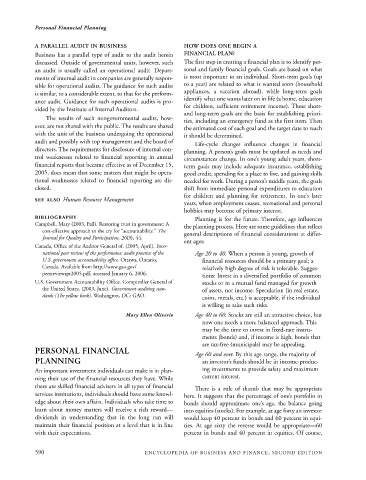Page 613 - Encyclopedia of Business and Finance
P. 613
eobf_P 7/5/06 3:18 PM Page 590
Personal Financial Planning
A PARALLEL AUDIT IN BUSINESS HOW DOES ONE BEGIN A
Business has a parallel type of audit to the audit herein FINANCIAL PLAN?
discussed. Outside of governmental units, however, such The first step in creating a financial plan is to identify per-
an audit is usually called an operational audit. Depart- sonal and family financial goals. Goals are based on what
ments of internal audit in companies are generally respon- is most important to an individual. Short-term goals (up
sible for operational audits. The guidance for such audits to a year) are related to what is wanted soon (household
is similar, to a considerable extent, to that for the perform- appliances, a vacation abroad), while long-term goals
identify what one wants later on in life (a home, education
ance audit. Guidance for such operational audits is pro-
for children, sufficient retirement income). These short-
vided by the Institute of Internal Auditors.
and long-term goals are the basis for establishing priori-
The results of such nongovernmental audits, how-
ties, including an emergency fund as the first item. Then
ever, are not shared with the public. The results are shared the estimated cost of each goal and the target date to reach
with the unit of the business undergoing the operational it should be determined.
audit and possibly with top management and the board of
Life-cycle changes influence changes in financial
directors. The requirements for disclosure of internal con-
planning. A person’s goals must be updated as needs and
trol weaknesses related to financial reporting in annual circumstances change. In one’s young adult years, short-
financial reports that became effective as of December 15, term goals may include adequate insurance, establishing
2005, does mean that some matters that might be opera- good credit, spending for a place to live, and gaining skills
tional weaknesses related to financial reporting are dis- needed for work. During a person’s middle years, the goals
closed. shift from immediate personal expenditures to education
for children and planning for retirement. In one’s later
SEE ALSO Human Resource Management
years, when employment ceases, recreational and personal
hobbies may become of primary interest.
BIBLIOGRAPHY Planning is for the future. Therefore, age influences
Campbell, Mary (2003, Fall). Restoring trust in government: A the planning process. Here are some guidelines that reflect
cost-effective approach to the cry for “accountability.” The
general descriptions of financial considerations at differ-
Journal for Quality and Participation, 26(3), 44.
ent ages:
Canada, Office of the Auditor General of. (2005, April). Inter-
national peer review of the performance audit practice of the Age 20 to 40. When a person is young, growth of
U.S. government accountability office. Ottawa, Ontario, financial resources should be a primary goal; a
Canada. Available from http://www.gao.gov/ relatively high degree of risk is tolerable. Sugges-
peerreviewrpt2005.pdf, accessed January 6, 2006. tions: Invest in a diversified portfolio of common
U.S. Government Accountability Office. Comptroller General of stocks or in a mutual fund managed for growth
the United States. (2003, June). Government auditing stan- of assets, not income. Speculation (in real estate,
dards (The yellow book). Washington, DC: GAO.
coins, metals, etc.) is acceptable, if the individual
is willing to take such risks.
Mary Ellen Oliverio Age 40 to 60. Stocks are still an attractive choice, but
now one needs a more balanced approach. This
may be the time to invest in fixed-rate instru-
ments (bonds) and, if income is high, bonds that
are tax-free (municipals) may be appealing.
PERSONAL FINANCIAL
Age 60 and over. By this age range, the majority of
PLANNING an investor’s funds should be in income-produc-
An important investment individuals can make is in plan- ing investments to provide safety and maximum
ning their use of the financial resources they have. While current interest.
there are skilled financial advisers in all types of financial
There is a rule of thumb that may be appropriate
services institutions, individuals should have some knowl- here. It suggests that the percentage of one’s portfolio in
edge about their own affairs. Individuals who take time to bonds should approximate one’s age, the balance going
learn about money matters will receive a rich reward— into equities (stocks). For example, at age forty an investor
dividends in understanding that in the long run will would keep 40 percent in bonds and 60 percent in equi-
maintain their financial position at a level that is in line ties. At age sixty the reverse would be appropriate—60
with their expectations. percent in bonds and 40 percent in equities. Of course,
590 ENCYCLOPEDIA OF BUSINESS AND FINANCE, SECOND EDITION

